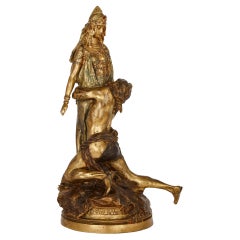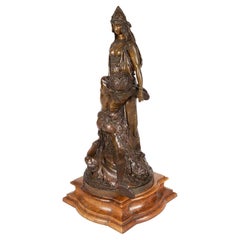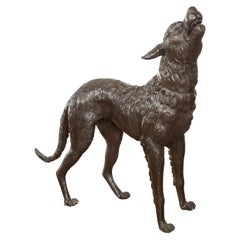Théodore Rivière Furniture
2
to
2
2
2
2
1
1
1
1
2
2
1
1
1
5,230
4,014
2,455
2,235
Creator: Théodore Rivière
Lost-Wax Bronze Sculpture by Théodore Rivière, Titled 'Carthage'
By Théodore Rivière
Located in London, GB
A lost-wax bronze sculpture by Théodore Rivière, titled 'Carthage'
French, Late 19th Century
Height 41cm, width 23cm, depth 18cm
This superb lost...
Category
Late 19th Century French Neoclassical Antique Théodore Rivière Furniture
Materials
Bronze
Carthage, A Patinated Bronze Group by Theodore Riviere
By Théodore Rivière
Located in Brighton, Sussex
‘Carthage’ – A Fine Patinated Bronze Group of Salammbô at Mathô's, By Theodore Riviere,
Signed ‘THEODORE-RIVIERE’ and titled "Carthage".
The s...
Category
Early 20th Century Théodore Rivière Furniture
Materials
Bronze
Related Items
Vintage Lost Wax Cast Bronze Sculpture of a Howling Dog with Textured Patina
Located in Yonkers, NY
A vintage lost wax cast bronze sculpture of a dog from the late 20th century, with textured patina. Created with the traditional technique of the lost-wax (à la cire perdue) which allows for great precision and finesse in the details, this bronze statue of a howling dog is all about texture! Standing firmly on his four paws, he is raising his head up, his open mouth revealing his teeth. Nicely detailed (his smooth collar contrasting with his long hair coat), this vintage bronze statue...
Category
Late 20th Century Théodore Rivière Furniture
Materials
Bronze
H 33.5 in W 10.5 in D 40 in
Mathurin Moreau Patinated Bronze Group of Angel and Cherub
By Mathurin Moreau
Located in New York, NY
Fine quality figural patinated bronze group of angel and cherub forms on oval base. Signed 'Moreau'
Artist: Mathurin Moreau (1822-1912)
Origin:...
Category
19th Century French Antique Théodore Rivière Furniture
Materials
Bronze
Bronze Sculpture Lioness / Roger Godchaux Jewish Artist & Susse Lost Wax Bibelot
By Roger Godchaux
Located in West Hollywood, CA
Bronze Sculpture Lioness / Roger Godchaux Jewish Artist & Susse Lost Wax Bibelot . An important bronze sculpture By the great Jewish Bronze Master animalier , Estampille
1- Cire perdue Lost Wax Stamp "La Lionne" by Roger Godchaux. See Photo
2- 2- With A Stamp of Susse. See Photo
3- 3- the signature of the Artist on the bronze. See Photo
Incredible Executed and very fine details with Dark Brown Patina with a hue of green . The movement of the lionesse is very graceful and sinuous (as most of the lion Sculpture he produced) Mounted on a black stone base 5 1/2" x 11 1/2" Antique Dealer West Hollywood CA Melrose Ave La Cienega Blvd. Godchaux Né à Vendôme le 21 décembre 1878 et mort le 6 mars 1958 à Paris.
Roger Godchaux Sculpteur animalier regularly produces animal drawings and paintings. Thus, unlike his sculptures which mainly represent wild animals, especially elephants and felines that he was going to study at the Jardin des Plantes, his paintings are often inspired by farm animals that he could observe in a small village of Brie where lived the mother of his companion. He also paints commissioned portraits or portraits of his family or friends, such as Gaston Switzerland or René Huchet .
But it is above all a sculptor. He made some works by direct carving of the wood. However, he mainly worked by modeling the earth. It treats surfaces by smoothing and oblique streaks. In this respect, unlike other animal sculptors like Édouard-Marcel Sandoz , François Pompon or Armand Petersen whose works are smooth, his work is close to the art of Paul Jouve which leaves apparent textures.
The lioness is finished with Godchaux’s distinctive surface modeling where the flesh is left textured like a wax model on the artists bench, still being formed and tooled. Godchaux’s animal work is characterized by gentleness and a sensitivity towards his subjects that showcases their playfulness and personality. This is captured beautifully in the present example where her curiosity and intensity of focus are fully developed; the anatomical and muscular realism is noteworthy. The naturalistic base is signed in his standard script “Roger Godchaux” and is also signed “Susse Fres. Edit. Paris” with the Susse cachet; a tiny stamp “France” is impressed into the edge below the cachet.
Models in mud are most often cast plaster. It is often in this material that he exhibits in Salons and galleries. The works for sale are cast in bronze. They are entrusted to famous founders like Susse , with whom he signs publishing contracts, or Valsuani . He also works with lesser known smelters like Gatti, Andro or Planquette. Some of his bronzes do not wear a cast iron seal. While there are some large models, most are modest in size, easily finding their place in collectors' homes.
Some of his works are terracotta or sandstone. Models were published by Susse both in bronze and terracotta. Terracotta remains raw or is glazed. He also worked at the Sèvres factory in the late 1930s. Roger Godchaux , born in Vendôme on December 21 , 1878 and dead the March 6 , 1958in Paris , is a painter , draftsman and sculptor of animals French . If all domestic and wild bestiary is part of his artistic universe, it is the wild beasts and elephants that have been his favorite subjects. Figurative sculptor, he represents the animal without artifice, in his attitudes of everyday life.
Roger Godchaux's father is an antique dealer. His mother, Jeanne Godchaux, is a concert pianist. He has a brother Yvan with whom he studies in Vendôme under the care of his maternal grandparents, music teachers in high school. Having joined Paris, he prepared in 1894 admission to the School of Fine Arts . He soon turned to animal art . He became a pupil of Jules Adler and Jean-Léon Gérôme . In 1896, he is a pupil of the Julian Academy . Great admirer of Antoine-Louis Barye , he will build a collection of works produced in the workshop of the master 1 . In 1905, he began to exhibit in Paris. He regularly participates in the Salon des artistes français .
In 1914, he was mobilized in Saint-Lô . Reformed, he is assigned to the offices of the Ministry of War. During this period, he put his drawing skills at the service of propaganda for the Allies. After the war, he saw rue Descombes . He resumes the exhibitions at the Salon des artistes français where, in 1922, he won the bronze medal. The state orders two bronze plates for the Army Museum Library . In 1924, his second companion gives him a daughter, Luce. In 1925, the jury of the International Exhibition of Modern Decorative and Industrial Arts awarded him a silver medal. In 1927, he won the contest of car manufacturer Chenard and Walcker for the creation of an emblem for their cars. In February 1928, the State bought him a bronze sculpture: Elephant , exhibited at the National Salon of animal artists, of which he becomes the treasurer in November of the same year. It was at this time that the Newark Museum in the United States bought him works. It was also in 1928 that he won the silver medal at the Salon des artistes français. In 1929, the state bought him a sculpture ( Pigeon ) again.
During the inter-war period, he exhibited regularly in various galleries: Galerie Charpentier , Galerie Georges Petit , Galerie Edgar Brandt , group of animals of the Malesherbes Art Gallery. He has friendly relations with other animals, including Henri Valette and Gaston Switzerland, with whom he regularly works at the Jardin des Plantes . In 1937, he signed a contract with the Manufacture Nationale de Sèvres for the edition of terracotta.
During the Second World War , he stayed in Paris and continued to work in his studio on Boileau Street , but was forced to wear the yellow star . He lives with his girlfriend and daughter Avenue de La Motte...
Category
Early 20th Century French Théodore Rivière Furniture
Materials
Stone, Bronze
H 5.25 in W 10.5 in D 4 in
Fine French Patinated Bronze Figural Group Titled Pro Patria by Edouard Drouot
By Edouard Drouot
Located in Los Angeles, CA
A very fine French antique patinated bronze figural group titled Pro Patria by Edouard Drouot
(French, 1859-1945) late 19th century.
Depicting a figure of winged Victory with a ...
Category
Late 19th Century French Late Victorian Antique Théodore Rivière Furniture
Materials
Bronze
H 30 in W 18 in D 9 in
Patinated Bronze Group of a Child Holding a Rooster "L'enfant au Coq"
By Adriano Cecioni
Located in London, GB
The expressive model featuring a toy cannon at the child's feet, all set on a circular marble base
The cannon signed 'Adriano Cecioni', with cartouche to the base inscribed 'ENFANT AU COQ...
Category
Late 19th Century Italian Antique Théodore Rivière Furniture
Materials
Marble, Bronze
Small Vintage Lost Wax Cast Bronze Snail Sculpture with Dark Patina
Located in Yonkers, NY
A vintage lost wax cast bronze snail sculpture from the mid 20th century with dark patina. We have several available. Created with the tradition...
Category
Mid-20th Century Théodore Rivière Furniture
Materials
Bronze
Walking Baby Elephant Lost Wax Cast Bronze Tabletop Sculpture with Dark Patina
Located in Yonkers, NY
A lost wax cast bronze sculpture depicting a walking baby elephant in dark patina. Created with the traditional technique of the lost-wax (à la cire perdue) which allows for great precision and finesse in the details, this bronze statue depicts a charming baby elephant that one can imagine is walking gingerly towards his or her mother. The left leg forward and the trunk neatly tucked in, the elephant is depicted with great details, from his tusks to his wrinkled skin. With its nice proportions and skillful depiction, this vintage lost wax cast bronze baby elephant table top...
Category
20th Century Théodore Rivière Furniture
Materials
Bronze
H 7.5 in W 12 in D 5 in
Italian Patinated Bronze Group Sculpture of Laocoon and His Sons, C. 1870
Located in New York, NY
An Italian grand tour patinated bronze group sculpture of Laocoon and his sons, After the antique by Agesander of Rhodes, C. 1870
Very nice qua...
Category
19th Century Italian Grand Tour Antique Théodore Rivière Furniture
Materials
Bronze
‘Gloria Victis’, A Patinated Bronze Figural Group by Mercié, Cast by Barbedienne
By Ferdinand Barbedienne
Located in Brighton, West Sussex
A Patinated Bronze Figural Group of ‘Gloria Victis’ (‘Glory to the Vanquished’), Cast by Ferdinand Barbedienne from the Model by Marius-Jean-Antonin Mercié (French, 1845-1916).
‘Gloria Victis’ (‘Glory to the Vanquished’).
Bronze, gilt and dark brown patina.
Signed 'A. Mercié', with foundry inscription 'F. BARBEDIENNE, Fondeur. Paris.' and A. Collas reduction cachet. The integral base titled 'GLORIA VICTIS'.
This cast is part of a limited edition by the Barbedienne Foundry.
France. Circa 1880.
‘Gloria Victis’ is one of the most recognisable and important works of sculpture of the nineteenth century and a definitive image of France’s historic national identity. The figure of glory, winged and wearing armour, carries a dying young warrior heavenwards towards fame and immortality. The compositional daring of the group must be admired for balancing two figures on the minimal support of one foot, wings spread in the moment before taking flight.
Mercié was a student at the French Academy of Rome when the Prussians invaded France in 1870. Shortly after the war had begun, he executed a group depicting the figure of Fame supporting a victorious soldier. When news reached Mercié in Rome that the French had surrendered, he decided to alter his group, replacing the victorious soldier with a defeated casualty, thus transforming an allegory of ‘Glory to the Victors’ into one of ‘Glory to the Vanquished’. Completed in 1872, a year after the defeat of French soldiers against the Prussian army, the statue personifies a defeated but heroic France. The title is also a reversal of the famous formula, ‘Vae Victis’ (Death to the Vanquished), which the Gallic general Brennus exclaimed upon defeating the Romans in 390 BC. The figure of the fallen soldier was thought to represent Henri Regnault, a fellow sculptor of Mercié who was killed on the last day of fighting.
Measuring 317 cm. high the original group of ‘Gloria Victis’ was unveiled in plaster at the Salon of 1872. It was bought by the City of Paris for the sum of twelve thousand francs and then cast in bronze by Victor Thiébaut for eight thousand five hundred francs. The bronze was exhibited at the Salon in 1875 and first placed in Montholon Square in the 8th arrondissement. In 1884 it was transferred to the courtyard of the Hôtel de Ville and in 1930, it entered the collection of the Musée du Petit Palais, where it can be seen to this day.
The Thiébaut Frères foundry also cast Gloria Victis bronzes for the cities of Niort (requested 1881) Bordeaux (requested 1883), Châlons-sur-Marne (today, Châlons-en-Champagne; requested 1890), and Cholet (requested 1901). In 1905, the Danish brewer and art collector Carl Jacobsen was permitted to have an exact cast made of the original sculpture in Paris, on condition that the base was made 2 cm lower and bore the inscription “Original tilhører Paris By” (The original belongs to the City of Paris). It too was cast by the Thiébaut Frères foundry. Gloria Victis was one of Jacobsen’s most important and his last acquisition. Today it has been returned to its original position in the Winter Garden at Glyptoteket, Copenhagen, Denmark.
The full-size plaster was shown again at the Paris Expositon universelle of 1878 alongside a bronze reduction by Barbedienne. By this time Antonin Mercié had entered into a commercial edition contract with the Ferdinand Babedienne foundry to produce bronze reductions of Gloria Victis, his most famous work. Gloria Victis is first recorded to have been produced in three sizes and by 1886 Barbedienne’s ‘Catalogue des Bronzes D’Art’ lists six sizes measuring 3/5, 9/20, 7/20, 3/10, 6/25 and 2/10, of the original. These reductions were produced by an invention of Barbedienne’s business partner Achille Collas. The Collas reducing machine was a type of complex mechanical pantograph lathe that enabled sculpture to be mathematically measured and transcribed to scale, in the round, thus making a reduced size plaster from which a bronze could be cast.
Mercié's modern sculpture had become an instant classic, even receiving an entry in the Nouveau Larousse Illustré. The success of the group undoubtedly lay in the fact that it was admired not just on an aesthetic level, but also on a patriotic level, particularly in its commemoration of heroism in defeat. Immediately ‘Gloria Victis’ was recognised as a national artwork, capable of arousing patriotism and casts were ordered from Barbedienne as local memorials commemorating the war’s dead for cities across France. ‘Gloria Victis’ was considered so much a part of France’s national identity that for the 1900 Paris Exhibition, Ferdinand Barbedienne’s nephew Gustave Leblanc, loaned a bronze example to feature as part of l’Exposition centennale de l’art français.
Literature:
For an interesting account of the process of creating a reduction in bronze of the Gloria Victis by Barbedienne and illustrations of the casting and finishing of the bronze see:
'Ferdinand Barbedienne': Theodore Child; Harper's new monthly magazine, Volume 73, Issue 436, September 1886.
‘Contemporary French Sculptors’: The Century, Volume 33, Issue 3, Jan 1887.
‘Modern French Sculpture’: Harper's new monthly magazine, Volume 76, Issue 452,
January 1888.
S, Lami, ‘Dictionnaire des sculpteurs de l'Ecole française au dix-neuvième siècle’, Tome III. G.-M., Paris, 1914, p. 432.
Peter Fusco and H.W. Janson, The Romantics to Rodin: French Nineteenth Century Sculpture from North...
Category
19th Century French Antique Théodore Rivière Furniture
Materials
Bronze
H 41.74 in W 16.54 in D 14.18 in
Contemporary Ram's Head Bronze Sculpture Lost Wax Casting Technique Green Patina
By Pablo Simunovic
Located in Firenze, IT
This contemporary solid bronze sculpture of a ram's head is inspired by the art of Ancient Rome and Ancient Greece with a reference
to neoclassicism.
The artist is able to attribute ...
Category
2010s Italian Neoclassical Théodore Rivière Furniture
Materials
Bronze
H 7.88 in W 12.21 in D 14.97 in
Lost Wax Cast Bronze Sculpture Inspired by Auguste Rodin's Eve on Marble Base
By Auguste Rodin
Located in Yonkers, NY
A lost wax cast bronze sculpture, inspired by Auguste Rodin's Eve in dark patina on black and white veined marble base. This item is available now and this is also a current producti...
Category
21st Century and Contemporary Théodore Rivière Furniture
Materials
Marble, Bronze
H 32 in W 11 in D 11 in
Small Vintage Lost Wax Cast Bronze Snail Sculpture with Verde Patina
Located in Yonkers, NY
A vintage lost wax cast bronze snail sculpture from the mid 20th century with verde patina. We have several available. Created with the traditio...
Category
Mid-20th Century Mid-Century Modern Théodore Rivière Furniture
Materials
Bronze
Théodore Rivière furniture for sale on 1stDibs.
Théodore Rivière furniture are available for sale on 1stDibs. These distinctive items are frequently made of metal and are designed with extraordinary care. There are many options to choose from in our collection of Théodore Rivière furniture, although gold editions of this piece are particularly popular. Many of the original furniture by Théodore Rivière were created in the neoclassical style in france during the early 20th century. If you’re looking for additional options, many customers also consider furniture by Eugene-Antoine Aizelin, Albert-Ernest Carrier-Belleuse, and Ernest Rancoulet. Prices for Théodore Rivière furniture can differ depending upon size, time period and other attributes — on 1stDibs, these items begin at $10,530 and can go as high as $19,112, while a piece like these, on average, fetch $14,821.



